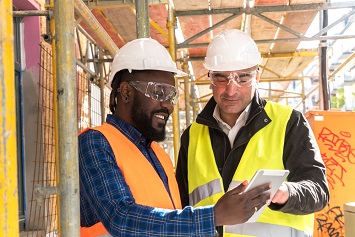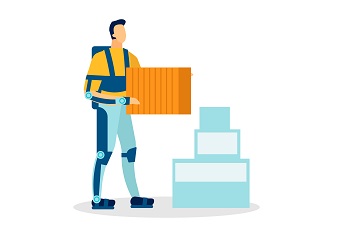Government researchers and private-sector developers deliver technological advancements all the time. Some could significantly transform the safety function—like in-vehicle monitoring systems that could improve driving performance by identifying risky driving behaviors and reducing the number of motor vehicle crashes. Wearable sensors that could alert construction workers of nearby vehicles and equipment, potentially eliminating struck-by hazards. Workers could use noise-measuring apps on their smartphones to determine if they are exposed to hazardous levels of occupational noise.
But adoption of new technologies can be slow. One survey showed that over 70% of contractors and subcontractors in the construction industry rely on paper or spreadsheets for tracking safety management information. Between 50% and 60% use desktop or laptop applications developed for accounting or project management.
It may be time for a refresher on what technology can do for you, technology that now includes artificial intelligence and machine learning, augmented and virtual reality, and the Internet of Things and wireless sensors.
For example, the Center for Motor Vehicle Safety (CMVS) at the National Institute for Occupational Safety and Health (NIOSH) recently published updated information about in-vehicle monitoring systems (IVMS). IVMS hardware deployed throughout a fleet and tied to performance dashboard can enable road safety professionals to identify fleet-wide problems and coach drivers on safer driving behavior.
An IVMS may consist of:
- Global Positioning System (GPS) that compares the vehicle’s speed against speed limits for specific road segments. The IVMS can be triggered to capture speeding event data when the driver or vehicle exceeds a pre-set threshold agreed upon by the company and IVMS provider, either speeds immediately above the speed limit or only when vehicles go more than 5 or 10 miles over the speed limit;
- Driver-facing video cameras that enable supervisors to show drivers specific behaviors they’re being coached to improve. Cameras also can provide critical evidence in a court case to show that the company driver was not responsible for a crash; and
- Accelerometers that allow the IVMS to detect vehicle maneuvers such as lane departures, harsh braking, or acceleration that can lead to crashes or near-crashes.
Before implementing an IVMS, employers should clearly communicate expectations for safe driving behavior. Employers may want to set IVMS-related goals for company drivers such as zero driving without a buckled seat belt or a 50% decrease in harsh braking events over a year. Employers also need to carefully evaluate workers’ overall pattern of driving behaviors. For example, harsh braking sometimes may indicate a driver made the safest choice and avoided a crash, but repeated harsh braking events over time may indicate driver fatigue or distraction.
Other new vehicle technology includes advanced driver assistance systems (ADAS), consisting of lane-departure warnings, forward-collision warnings, and automatic emergency braking. One day, autonomous, or fully self-driven, vehicles may greatly reduce crashes and injuries by eliminating human error, which is implicated in over 90% of crashes. While the technology is being tested today, it likely will be years?even decades?before self-driving vehicles become commonplace.
CMVS plans to evaluate the effectiveness of advanced driver assistance systems and automated driving systems, in-vehicle technologies, as well as worker acceptance of them.
Promising Technologies
The National Safety Council’s (NSC) Work to Zero initiative earlier this year completed its study of the most promising technologies aimed at addressing 18 different non-roadway hazardous situations in which workers are most likely to die. The group looked at the environment, health, and safety (EHS) technologies that professionals see as most potentially effective and released a report, “Safety Technology 2020: Mapping Technology Solutions for Reducing Serious Injuries and Fatalities in the Workplace.”
Three popular technologies that could have a big impact on safety are artificial intelligence, aerial drones, and virtual reality.
A branch of artificial intelligence called machine learning can be used to predict and analyze safety and risk hazards. For example, machine learning (ML) and artificial intelligence (AI) can help prevent workplace violence by monitoring body-worn or fix-mounted video cameras for workplace abnormalities. ML and AI applications have the ability to detect patterns of behavior and movement that could indicate physical violence without workers needing to identify aggressive behaviors directly.
Drones, aerial vehicles operated by a ground-based human controller, have a long history of military use but have become common recreational devices for taking photographs or videos. Employers can use drones to assess site feasibility, inspect internal and external spaces, and map topographic locations. Drones can replace human workers in confined spaces and to perform material or structural inspections at heights.
Virtual reality (VR) technology allows users to enter computer-generated environments and navigate them as if they are physically there. While popular in gaming applications, virtual reality is also growing as an educational and training tool.
Using VR headsets, workers can train on complex or dangerous tasks by immersing themselves into a 3D-environment developed to meet specific training requirements. Workers can become proficient in their duties or safety interventions in a VR simulation instead of being exposed to higher risk situations before they are fully trained.
Sensors Have Potential
Sensors or detectors have also shown promise in reducing injuries and fatalities or even detect worker fatigue, a common precursor to worker injuries.
Researchers at Miami University of Ohio experimented with the use of body sensors to detect and measure fatigue. Study participants were outfitted with four inertial measurement units placed on the chest, hip, wrist, and ankle. Participants then were given a series of tasks to perform during three-hour sessions of continuous work.
Researchers found that wearable sensors can detect physical fatigue in a number of different occupational settings. By monitoring body movements, wearable sensors can detect the starting point of fatigue and alert workers and supervisors to the need for individualized intervention.
CPWR—The Center for Construction Research and Training looked at the potential for wearable sensors to alert construction workers to nearby vehicles or equipment, preventing caught between and struck-by injuries. Researchers developed a waist belt embedded with a series of vibrating motors worn by participants. The motors received signals from a hazard alert system that runs on a laptop or mobile device and monitors equipment and vehicles at a site.
NIOSH researchers have looked at the potential for a “smart” safety helmet equipped with sensors that can detect carbon monoxide and methane. While air sampling has been miniaturized to handheld devices, the technology has not yet been implemented in wearable devices.
Other potential applications of wearable technology under could include:
- Physiological status monitors that collect worker data in outdoor environments and could alert workers or supervisors to the potential for heat stress;
- Environmental sensors to monitor air quality, including carbon monoxide, hydrogen sulfide, and gas leaks, as well as, noise; and
- Exoskeletons to reduce the physical stress of manual labor and prevent musculoskeletal disorders (MSDs).
The American Industrial Hygiene Association (AIHA) would like to see the use of sensors combines with data analysis and other technologies to get a better sense of workers’ total exposures to safety and health hazards. AIHA said analyzing sensor data could help safety and health professionals better understand the interaction between workers’ occupational and nonoccupational exposures.
NIOSH has pointed out that barriers to widespread adoption of wearable technology that include cost–while a Bluetooth-enabled sensor typically costs $35, a radio frequency identification (RFID) device can cost $1,000–maintenance, and privacy concerns. Labor unions and other workers’ advocates have expressed concern that wearable devices could be used for productivity monitoring, tracking an employee’s location, hours worked, breaks, or even number of steps taken during a workday.
Industrial Exoskeletons
NIOSH also recently acknowledged a need for further study of robotic exoskeletons. While manufacturers claim robotic devices boost productivity and work quality while reducing the risk of work-related musculoskeletal disorders (MSDs), benefits and risks of industrial exoskeletons have not been well studied.
Industrial exoskeletons include back-assist, leg-assist, and shoulder-assist devices, which are powered by electric motors, hydraulics, pneumatics, or a combination of the three technologies.
Existing studies have only involved small numbers of participants—many studies had fewer than 15 participants—usually in laboratory settings.
There have been anecdotal reports of compressed nerves and pressure wounds from prolonged exoskeleton use, exoskeletons that move the wearer’s joints beyond normal range of motion, and an over-reliance on exoskeletons to address risks that could be better addressed by other interventions.
However, exoskeletons have the potential to reduce MSDs in the healthcare sector by assisting with patient handling, reduce hand-transmitted vibrations, and aid in materials handling in the wholesale and retail trades. More study is needed.
Smartphone Noise Measurement
NIOSH has repeatedly looked at the potential for smartphone noise measurement apps to alert workers, supervisors, and occupational safety and health managers to hazardous levels of occupational noise. Researchers have evaluated apps using both built-in smartphone microphones and calibrated, external microphones.
NIOSH found huge variations in accuracy of noise measurement apps when used with built-in smartphone microphones. They found the use of calibrated, external microphones greatly improved the accuracy and precision of smartphone sound measurements and removed much of the variability and limitations found with the built-in smartphone microphones.
The institute developed its own NIOSH Sound Level Meter (NIOSH SLM) app for iOS devices, available for download from the Apple iPhone app store.
NIOSH wanted to develop a smartphone-based app that had the accuracy and functionality necessary to conduct occupational noise measurements that consumer apps lacked. Hearing loss researchers at the institute collaborated with app developer EA LAB to create a sound-level meter app that measures and characterizes occupational noise exposure similar to professional instruments.
EA LAB and NIOSH researchers tested the app’s performance using an iPhone and external microphone and found it met American National Standard Institute (ANSI) standards for sound level meters.
A Time and Place for Tech
Useful technology is not limited to artificial intelligence, VR headsets, and wireless sensors. Sometimes it can be a simple as compressed air pumped through a tube.
Cincinnati, Ohio-based Vortec makes a “personal air-conditioning vest” to prevent worker heat stress. Vortec’s personal cooling vest consists of a cooling tube and belt that pumps cold compressed air through the tube inside a plasticized PVC vest through which the cold air flows to cool the worker’s torso.
A healthy dose of skepticism is okay when it comes to safety technology. Vendors should have to back up their product claims with proof. Remember, robotic exoskeletons may protect workers from injury, but we don’t yet know.



